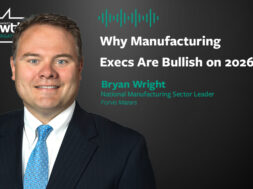Grading M&A on a Curve—ACG’s Mid-Year Market Update
The first half of 2025 fell short of expectations for middle-market dealmaking. Signs suggest the back half of the year could be stronger, according to a recent webinar featuring GF Data and Forvis Mazars.

How did mid-market M&A activity in 2025 stack up against expectations at the start of the year?
According to nearly half (48%) of respondents to a poll during ACG’s recent mid-year market update webinar, dealmaking missed the mark.
The Sept. 25 webinar’s featured speakers—Bob Dunn, managing director of GF Data, and Forvis Mazars’ Scott Linch, managing partner, Capital Advisors, and the firm’s national private equity sector leader—generally agreed with that assessment of market performance, based on deal data collected by GF Data from more than 330 private equity contributors and Linch’s firsthand experience working on M&A engagements.
Event Recap
WHAT: 2025 M&A Mid-Year Recap & Outlook Members-Only Webinar
WHEN: Sept. 25
THE TAKEAWAY: While H1 ’25 didn’t live up to dealmakers’ expectations, the data suggests the second half of the year could turn out stronger.
GF Data, an ACG company, tracked 142 deals valued between $10 million and $500 million in the first two quarters of 2025—a 28% decline from 2024. “Coming in, I was expecting a vibrant 2025 that was going to eclipse 2024, but in reality, we’re not going to even make it to 2024 levels,” said Dunn.
Uncertainty around tariffs and elevated interest rates contributed to the slower-than-expected start to 2025—a year that dealmakers entered optimistically following President Trump’s election. Although the M&A count improved after Q1, the numbers didn’t catch up to the prior year. GF Data contributors reported 142 deals in the first half of 2025, a 30% decline compared to the 204 transactions completed during the first half of 2024.
During the one-hour webinar, presented exclusively for ACG members and GF Data subscribers, Dunn and Linch discussed the drivers and obstacles behind M&A activity in the middle market, along with valuation levels, debt coverage, and more.
Premium Pressure for High-Performers
Despite declining deal counts, average valuation multiples have remained relatively consistent in recent years, hovering at 7.2x total enterprise value-to-EBITDA since 2023 through the first half of 2025, according to GF Data’s figures.
Companies with above-average financial performance make up one category that has seen notable movement, however.
Classified by GF Data as having greater than 10% trailing 12-month (TTM) EBITDA margins and greater than 10% TTM revenue growth, these high-performing companies have seen their premiums erode in recent quarters. The average premium paid for buyouts of high performers over other companies reached 7% in mid-2024—an all-time low for deals tracked by GF Data at that time—and fell further in the first half of 2025, to about 5%.
Dunn noted that companies in the high-performing bucket saw lower performance on average than in past years, which has in turn reduced their valuations and lowered the average purchase price multiples for the high-performing category.
Another factor in the premium’s tightening is the increased prevalence of add-on acquisitions, which made up about 40% of buyouts tracked by GF Data through the first half of this year, up from a historical average closer to 30%, Dunn noted.
Challenging debt markets and a desire to bolster platform portfolio companies has increased competition for add-ons and driven up prices. Add-ons tend not to meet GF Data’s criteria for high performance and thus have contributed to higher prices on average for companies in the non-high-performing category.
The Lending Lowdown
The debt markets of the past few years have reacted to rising interest rates, the insolvency of Silicon Valley Bank and other lending institutions, and an influx of debt funds and alternative financing sources that sought to fill a banking void.
The M&A community has welcomed recent interest rate cuts and more lenders have entered the market, yet debt coverage hasn’t improved much, according to the data.
GF Data’s figures showed total debt-to-EBITDA for platform buyouts held steady at 3.3x from 2023 through the first half of 2025. “I would have expected an increase by a tenth or two-tenths of a turn of EBITDA for 2025, but it just hasn’t materialized,” Dunn added.
Senior debt, meanwhile, experienced a decline of .2x EBITDA for the first half of 2025. “With a resurgence of banks, that kind of surprised me, as well as the amount of money being raised by debt funds,” Dunn said. “I would have expected coverage to have improved.”
Linch attributed these leverage trends in part to the relatively small nature of the rate cuts, along with widespread issues among portfolio companies in servicing their existing debt loads.
What’s Ahead
Continued rate reductions and increased comfort with ongoing uncertainty could be a boon for M&A in the coming months, particularly for business owners in the lower middle market who are exhausted from navigating various economic headwinds.
There’s a perception of greater stability now, Linch noted, as businesses work through tariffs and other issues, and interest rates begin to tick downward. Businesses that weathered the vagaries of the market and continued to post strong results may have more confidence in pursuing a transaction.
“Now is kind of a good time to go and take those businesses out,” Linch said. “That’s what we’re seeing right now: People just learned how to deal with this instability. If their companies are still performing, it’s a nice time to go back out and take them to market.”
Katie Maloney is ACG’s Vice President, Communications & Content.
Middle Market Growth is produced by the Association for Corporate Growth. To learn more about the organization and how to become a member, visit acg.org.


